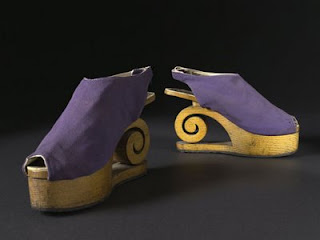 I read a very interesting piece by Angelique Chrisafis in the Guardian this morning, about wartime, ration-book fashion in Paris.
I read a very interesting piece by Angelique Chrisafis in the Guardian this morning, about wartime, ration-book fashion in Paris.The French capital is hosting an exhibition at the Jean Moulin Museum to celebrate the ingenious ways French women, under the Nazi Occupation, managed to stay fashionable, using all manner of materials from scraps of cellophane, to bits of straw and from pieces of wood to fabric from old sofas. The platform shoes in the photograph were fashioned out of blocks of wood and pieces of canvas. As hot water was scarce, a new fashion was created when les femmes de Paris took to wearing turbans (made from paper or straw) to disguise their dirty locks.
The article quotes one of the show's organisers, Fabienne Falluel the fasion historian: "Women knew how to sew, and in that dark period they still took ideas from magazines and the street, but they made the pieces themselves. Today people don't necessarily know how to sew - we're still in a culture of consumption where the instinct is to buy, not make. But you'll see, people will soon start learning." I do hope you're right Fabienne.
There has always been a small (and recently growing) section of the population that possesses the skill of sewing and takes pleasure from making clothes and using unusual and interesting materials to do so. The sad fact remains that this is a significantly smaller proportion of the populace than was the case during the War, or even 20 to 30 years ago.
The disappearance or reduction of the domestic sciences from school curricula must account for some of this loss of skill. But if people really wanted to learn to sew they could have learned from mothers and grandmothers. The fact that they haven't, lies with Mde Falluel's point that we are living in a culture of consumption.
 I grew up knowing how to sew. My mother was a good role model and I was taught at school. As a teenager, I made most of my own clothes and could follow a pattern with ease. Until I had a go at making a simple summer shift dress last year, I had not touched a sewing machine in 25 years.
I grew up knowing how to sew. My mother was a good role model and I was taught at school. As a teenager, I made most of my own clothes and could follow a pattern with ease. Until I had a go at making a simple summer shift dress last year, I had not touched a sewing machine in 25 years.Why is this? Lack of time maybe? - but had I really wanted (or needed) to do it I could have made time. There was a period in my life when I was a heavy spender on fashion and happy to pay for designer names, so there was no place in my life then for something run up on the old Singer. Most importantly and enduringly since, clothes simply cost too little to justify the time and effort to make them yourself. As a result many of us have acquired the behaviour of buy and wear for a season then chuck it away and buy new. At least my years of designer indulgence provided some classics that stood the test of time, but mostly the trend has been away from classics to disposable chic. Wear today, bin tomorrow. In such a climate of consumption there is no place for sewing. Creativity is reserved for mixing bought pieces together, not for fashion resourcefulness.
Is Mme Falluel right in saying we will start learning? Yes I believe she is. Making your own clothes is not just about thrift. There is also the creativity that goes into not just the making, but in the unique combination of fabric and pattern that makes your garment unlike any other. There is also the huge sense of pride and personal achievement that goes into wearing something you have created yourself. Careful fitting and adjustment of the pattern means there is also the means to ensure your garment fits you like a glove.
Looking at the craft-based blogosphere with the explosion of people show-casing their handiwork and the ever-increasing number selling their creations on sites like Etsy, indicates that we are seeing the start of a revolution. The recent dramatic increase in sales of sewing machines and haberdashery items backs this up.
Let's hope we will never face a need as great as the ladies of 1940s Paris, but that we will in future be able to apply a similar level of resourcefulness and skill to the creation of our own unique and stylish clothes.
No comments:
Post a Comment